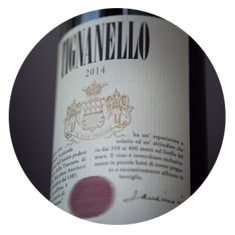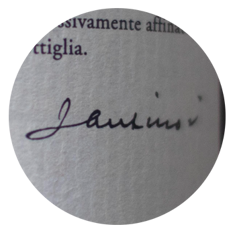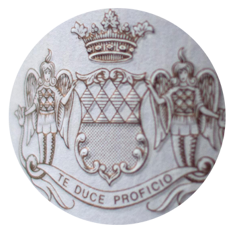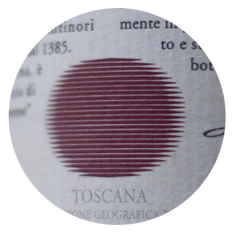Tignanello
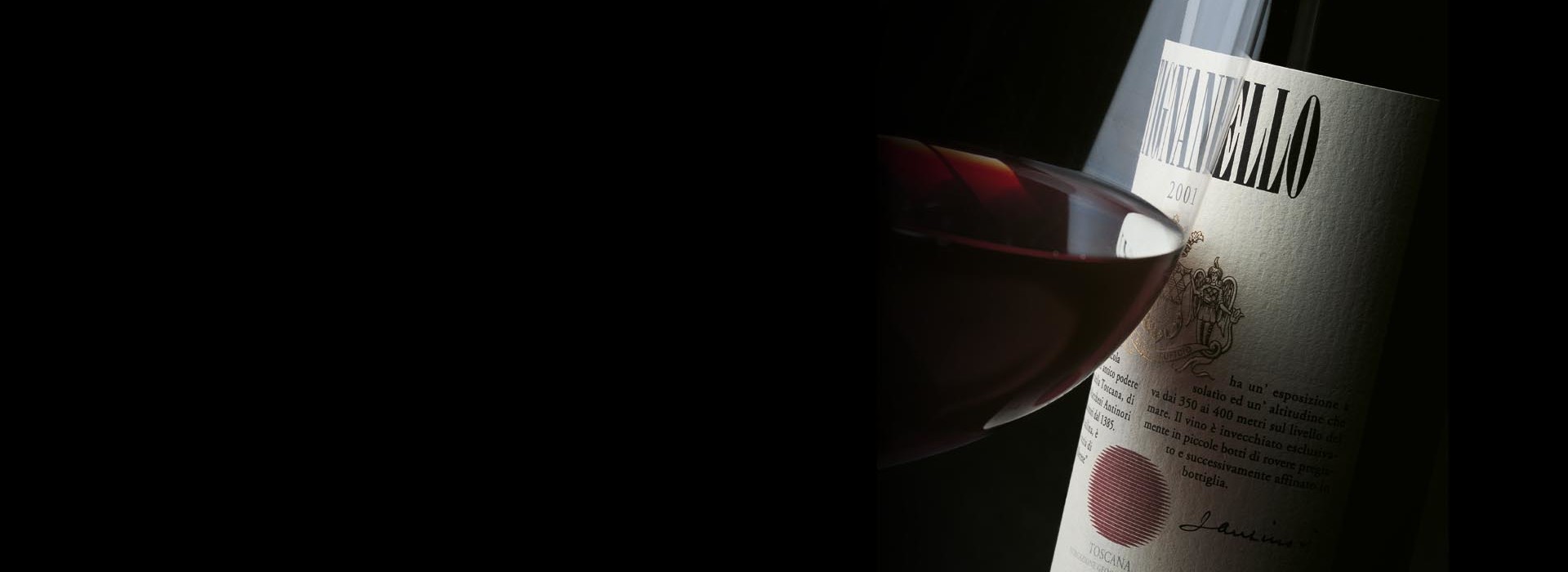
The Wine
Tignanello was the first Sangiovese to be aged in barriques, the first contemporary red wine blended with untraditional varieties (specifically Cabernet) and one of the first red wines in the Chianti Classico region that didn’t use white grapes. Tignanello is a milestone. It’s produced with a selection of Sangiovese, Cabernet Sauvignon and Cabernet Franc.
Historical Data
Tignanello is produced exclusively from the vineyard of the same name, a parcel of some 190 acres (77 hectares) with limestone-rich soils and a southwestern exposure at 1150-1325 feets (350-400 meters) above sea level at the Tignanello estate. It was the first Sangiovese wine to be aged in small oak barrels, the first modern red wine to use such non-traditional varieties as Cabernet in the blend, and among the first red wines from the Chianti Classico area to be produced without white grapes. The wine, originally called "Chianti Classico Riserva Vigneto Tignanello" (a Chianti Classico Riserva from the Tignanello vineyard), was produced for the first time from a single vineyard parcel in 1970, when the blend contained 20% of Canaiolo and 5% of Trebbiano and Malvasia, both white grapes, and the wine aged in small oak barrels. In 1971 it became a Tuscan red table wine rather than a Chianti Classico, and was called Tignanello. In the 1975 vintage the percentage of white grapes was definitively eliminated from the blend. Ever since 1982, the blend has been the one currently used. Tignanello is bottled only in favorable vintages, and was not produced in 1972, 1973,1974, 1976, 1984, 1992, and 2002.

The Wine
Tignanello was the first Sangiovese to be aged in barriques, the first contemporary red wine blended with untraditional varieties (specifically Cabernet) and one of the first red wines in the Chianti Classico region that didn’t use white grapes. Tignanello is a milestone. It’s produced with a selection of Sangiovese, Cabernet Sauvignon and Cabernet Franc.

The Design
The label was designed by Silvio Coppola in 1974 for the release of Tignanello 1971. The idea to commission this artist was discussed at an event at Castello della Sala in 1973. Silvio Coppola was an important Italian graphic and interior designer who was famous for his minimalist lighting fixtures and austere furniture but also for book cover designs for Italian publishing company Feltrinelli. Silvio Coppola was the perfect match for the job.
The Signature
Marchese Piero Antinori, the current Honorary President, decided to have his father, Niccolò Antinori, sign the label as a sign of recognition for his father’s confidence in him.
Te Duce Proficio
The historic family crest of the Antinori family
The Sun
Tignanello’s stylized “Sun” by Silvio Coppola
Climate
The autumn of 2009 and the winter of 2010 were characterized, in the Chianti Classico zone, by ample rainfall and by decidedly cold temperatures; snow arrived towards the end of 2009 and occasional snowfall continued until the early part of March. This phase of the growing season caused a sustained period of repose in their vegetative activity for the vines, and this, along with regular rainfall during the first part of spring, led to a delayed arrival of bud break compared to seasonal norms. April, May, and June, a critical moment in vine development and growth, saw much rainfall; this, together with lower than average temperatures, led to a general delay in the cycle of the growing season in all of the varieties cultivated in the Tignanello vineyard. True summer weather did not begin until the month of July which, with its elevated temperatures and a completely dry climate, contributed to an excellent development of the grape bunches and a recovery of the ripening time previously lost. The climate changed once again towards the end of July and during the first half of August, with rather low temperatures for the period and three significant rainstorms which slowed down the color change in the grapes. This climate during the growing season made a careful selection of the grapes quite necessary, a selection aimed at limiting the production of grapes per vine and, above all, at assuring that the bunches be as healthy as possible. Picking operations began towards the end of the month of September, a month which alternated periods of warm, sunny, and windy days with others with occasional cloudbursts, at times rather intense, followed by powerful north winds which rapidly dried both the grapes and the overall micro-climate of the vineyard. The warm days and the cool evenings and nights, instead, assisted a complete physiological ripening of the grapes. The healthiness of the grapes, an important richness of color and aroma and a powerful varietal character were already evident as soon as the grapes reached the cellars and initial phases of fermentation began, all characteristics which suggested a vintage of a high quality level. Total annual rainfall: 134 centimeters (53.6 inches) Average daily temperatures April 1st – October 31st: 18.4 ° centigrade (65.15° Fahrenheit) Rainfall April 1st – October 31st: 65.8 centimeters (26.3 inches)
Vinification
After the hand sorting the berries were crushed and transferred in a conical tank fermenter. Fermentation and maceration lasted 15-20 days ans was managed using mainly punching-down in order to avoid strong mechanical actions on the skin. The result was a wine with much softer tannins and better balance. After the juice was separated from the skins, the wine was put through a complete malolactic fermentation in small oak barrels. The aging process then began and lasted approximately twelve to fourteen months; during this period, the various lots, fermented and aged separately by variety and plot by plot, developed in barrel and then, a few months before bottling, were assembled and blended. After the bottling, the periodof ageing in bottle was approximately 12 months.
Historical Data
Tignanello is produced exclusively from the vineyard of the same name, a parcel of some 190 acres (77 hectares) with limestone-rich soils and a southwestern exposure at 1150-1325 feets (350-400 meters) above sea level at the Tignanello estate. It was the first Sangiovese wine to be aged in small oak barrels, the first modern red wine to use such non-traditional varieties as Cabernet in the blend, and among the first red wines from the Chianti Classico area to be produced without white grapes. The wine, originally called "Chianti Classico Riserva Vigneto Tignanello" (a Chianti Classico Riserva from the Tignanello vineyard), was produced for the first time from a single vineyard parcel in 1970, when the blend contained 20% of Canaiolo and 5% of Trebbiano and Malvasia, both white grapes, and the wine aged in small oak barrels. In 1971 it became a Tuscan red table wine rather than a Chianti Classico, and was called Tignanello. In the 1975 vintage the percentage of white grapes was definitively eliminated from the blend. Ever since 1982, the blend has been the one currently used. Tignanello is bottled only in favorable vintages, and was not produced in 1972, 1973,1974, 1976, 1984, 1992, and 2002.
Tasting Notes
An intense ruby red in color, the aromas of the wine are characterized by a powerful varietal expressiveness, with ample notes of red fruit, raspberries, and liquorice. On the palate, the wine, still very young, immediately shows firm tannins with much polish and finesse as well, along with a balancing, tonic acidity and savory mineral notes which add length and persistence to the finish and aftertaste.
Awards
Vinous 96/100 James Suckling 96/100
Scheda
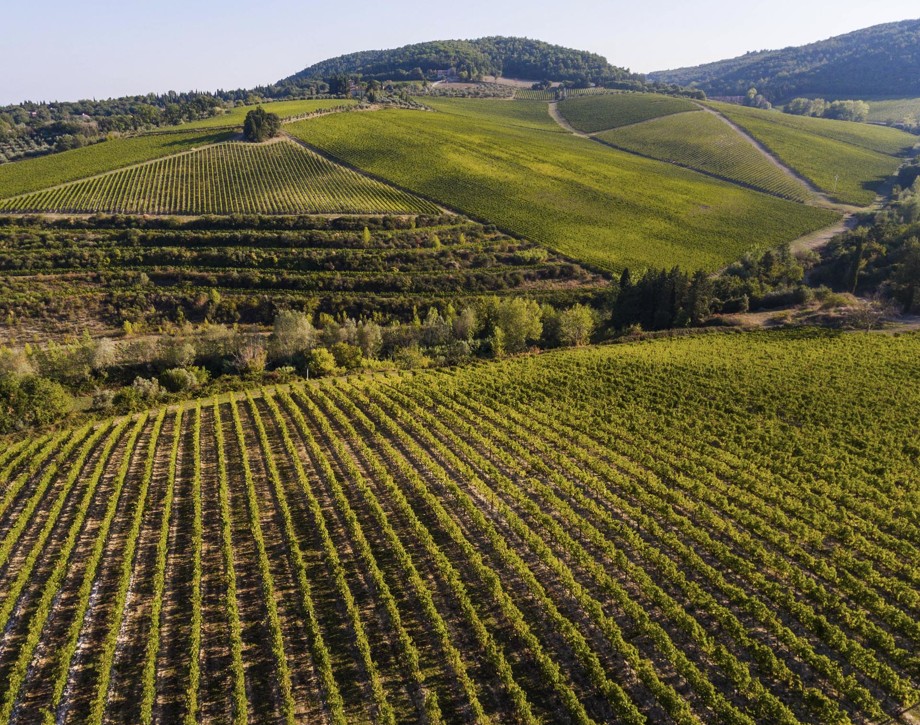
Tenuta Tignanello
The Tenuta Tignanello estate is in the heart of Chianti Classico, in the gently rolling hillsides between the Greve and Pesa river valleys. It extends over an area of 319 hectares (788 acres), of which about 165 (407 acres) are dedicated to vines. Two of the estate’s prized vineyards are on the same hillside, Tignanello and Solaia, on soils that originated from marine marlstone from the Pliocene period rich in limestone and schist. The vines enjoy hot temperatures during the day and cooler evenings throughout the growing season. The estate’s two signature wines, Solaia and Tignanello, are produced from these vineyards and have been defined by the international press as “among the most influential wines in the history of Italian viticulture”. According to Marchesi Antinori, Solaia and Tignanello are an ongoing challenge and a never-ending passion. The Tignanello estate has vineyards of indigenous Sangiovese grapes as well as some other untraditional varieties such as Cabernet Franc.
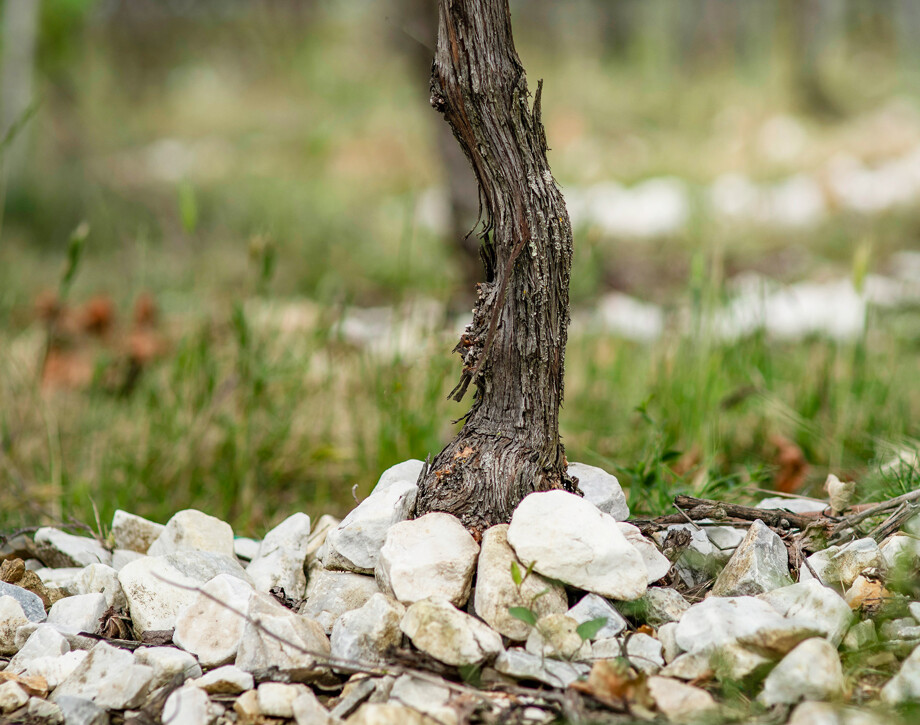
Soil
Calcareous rocky soils with alberese (marl limestone) and marl.
